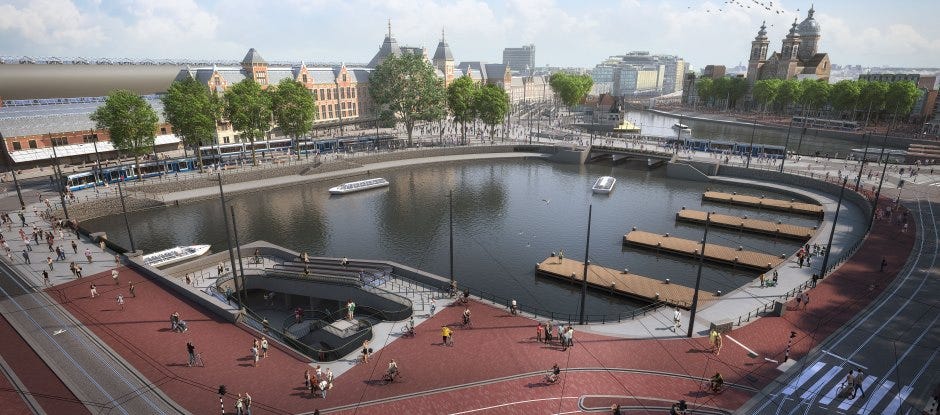Going underground (and underwater)
A peek at Amsterdam's newest addition to its extensive bicycle infrastructure. Why it's more than just a luxury.
A new underground bicycle parking garage is opening this week in Amsterdam, directly adjacent to the main train station, Amsterdam Central. It’s not only underground, it’s underwater, the first such bicycle garage in the world, we are told. The building was constructed under one of the two small harbors in front of the train station, which is surrounded by water. A local news site, AT5, published a short video clip last week of the inside of the new structure. Mark Wagenbuur, an enthusiastic Dutch Cycling Ambassador who publishes the blog Bicyle Dutch, grabbed some screencaps from the video and posted various images on Twitter, and I share some of his material below. I close with a few remarks on Dutch infrastructure and the thriving bicycle culture here.
First, here are two artist renderings published by the city government:
Some of the materials shared by Mark Wagenbuur:
The city published a time-lapse video of the construction site. Four years in sixty seconds:
The new underground bike garage is just the first of two. Later this year, a second will be opening on the riverfront side of Central Station.
With a capacity of 7,000 bikes, the new one open this week is certainly big, but the honor of the largest bicycle garage in the country (and the world?) goes to the beautiful city of Utrecht, with its mammoth Fietsenstalling Stationsplein Utrecht, with a capacity of 12,000 bicycles.
In practical terms, you swipe your public transport chip card when you enter. The first twenty-four hours are free, after that it’s €1,25 per day. Having used these parking garages in various places, in Amsterdam and elsewhere, it’s a great system; perhaps the biggest challenge is remembering where you’ve parked your bike; one pair of chrome handlebars bears a startling resemblance to umpteen thousand others.
If you’ve ever visited the Netherlands, you’ll have seen that the physical infrastructure here in top-notch. In one sense, it has to be: much of the country was build over the past millennium on land reclaimed from vast tidal estuaries, from swampy peat bogs and shallow lakes. Owing to natural subsidence, around a third of the country now lies technically under sea level. Keeping our collective feet dry has been an endless struggle; only in the mid 20th Century did the country finally gain the upper hand over sea and river.
Robust infrastructure is therefore an existential matter; the country could never allow scenes to take place like we saw in New Orleans in 2005 when Hurricane Katrina visited its wrath on the region. While the Netherlands has embraced neoliberal economic policies with a vengeance over the past thirty years or so — we live in an age of permanent austerity — even the most fervent slashers of public spending here appear to understand that physical infrastructure is off limits.
That said, infrastructure is said to pay for itself, so perhaps that partly explains why the country continues to invest heavily in it. I have no idea what the direct economic benefits of building bicycle garages are; I suspect they are second-order, as just one of many key nodes in a vast multi-mode public transportation network. Owing to its strategic location on the estuaries of important rivers like the Rhine and the Maas (Meuse), the country has long been a major trading center, going to back to the Middle Ages and its active role in the pioneering Hanseatic League. In the aftermath of the stagnation of the 1970s, the government pushed hard to expand its position as a transport and logistics hub, as well as become a major exporter. If this densely-populated country did not have an adequate public transportation network and everyone needed a car to get around, the roads would become choked with traffic and the economy would grind to crunching halt. Holland would quickly turn into one huge traffic jam.
In the photo at the very top of the page, the only one that I took, you see the entrance to the bicycle passage under the Rijksmuseum, Holland’s most famous museum. Some years ago it underwent a massive renovation which dragged on for ten years. Among other things, they moved the main entrance from the front of the building to the broad pedestrian and bicycle passageway under the building. As part of the renovation, the museum wanted to close it off to bicycle traffic, claiming that would represent a “traffic hazard”. The vociferous bicycle lobby fought to keep it. The latter finally prevailed and it remained. In practice the arrangement works fine; tourists wander through the passageway towards the stately new underground entrance, cyclists whizz by, and buskers take advantage of the very fine acoustics of the space. Visitors to the city will realize, if they haven’t already, that bicycles are everywhere. It’s a fitting symbol for Amsterdam of that happy symbiosis.
Oh, one more thing: visitors think it’s always been this way. It hasn’t. Cars overran Amsterdam in the 1960s and 70s, choking its narrow streets, just like everywhere else, but decades of hardworking activists demanding safer streets and a less car-centric approach to city life found a receptive ear in visionary city planners, producing the results you see today. It didn’t happen overnight.















Hi Colin, Just read this in reference to you earlier comment about technocratic dystopia being impossible to maintain, in case you missed it. https://brownstone.org/articles/technocratic-dystopia-is-impossible/
Very impressive. Not very practical everywhere, but impressive.